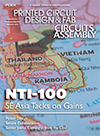Additive Manufacturing: A Dynamic and Innovative Industry Set to Surpass US$41 Billion by 2033, Says IDTechEx
Since the invention of the first 3D printing technologies in the early 1980s, the 3D printing market has experienced a tremendous amount of innovation and interest. A niche technology until the expiration of key patents, the 2010s allowed many startups to emerge offering inexpensive consumer-level 3D printers. The subsequent media frenzy in the early 2010s thrust 3D printing into the limelight, accompanied by major multinational corporations like HP and GE entering the 3D printing space. After years of hype, the industry has moved on to a more critical examination of the value-add that additive manufacturing brings to businesses and supply chains. Despite the obstacles posed by the COVID-19 pandemic and persistent supply chain disruptions, the additive manufacturing market continues to find new applications and end-users. IDTechEx forecasts that 3D printing's continued innovation and meaningful adoption will lead the hardware and consumables market to surpass US$41 billion by 2033.
IDTechEx has studied the 3D printing industry for over a decade and has released their latest report, “3D Printing and Additive Manufacturing 2023-2033: Technology and Market Outlook”, providing the most comprehensive view of the market. In examining thirty individual 3D printing technologies and five major material categories, IDTechEx finds a continuous theme between these important aspects of the industry: expansion.
Evolution of Market Shares for 3D Printing Technologies and Materials 2022-2033. The IDTechEx report includes eighty 10-year forecast lines. Source: IDTechEx - "3D Printing and Additive Manufacturing 2023-2033: Technology and Market Outlook"
Given that established additive manufacturing technologies like selective laser sintering and thermoplastic filament extrusion are decades old, it might be expected for the market to consolidate and stabilize from a technology standpoint. However, new entrants with their own unique innovations on 3D printing are popping up every year, some of which are so unique that they don't fit into the classic seven printing processes framework. New technologies, which span polymer, metal, electronics, ceramics, construction, and composite 3D printing, offer different advantages and disadvantages to incumbents. Parallel to these new technologies are more incremental improvements in established processes. What both advancements allow is access to new applications and end-users that 3D printing previously struggled to reach.
Taking place in tandem with the expansion and improvement of the 3D printing hardware portfolio is the growth of the broader 3D printing ecosystem, including materials, post-processing, software, and services. For example, the 3D printing materials portfolio is expanding because of the aforementioned new technologies entering the market, which can process materials previously underused or underutilized by additive manufacturing. In addition, the software, scanners, and services sector of 3D printing is introducing new offerings to simplify the adoption of additive manufacturing by end-users, making their experience more seamless.
Across these different technologies, materials, and services, the theme remains the same: the expansion of additive manufacturing to enter new target markets and reach new end-users. IDTechEx expects this expansion to drive the 3D printing industry past US$41 billion in hardware and materials sales by 2033.
Market Forecasts for Additive Manufacturing Materials
The new report from IDTechEx, "3D Printing and Additive Manufacturing 2023-2033: Technology and Market Outlook", carefully segments the market by eighty different forecast lines across seventeen different technology categories, four major material categories, and eight material subcategories. These hardware and material forecasts analyze future installations, hardware unit sales, hardware revenue, materials mass demand, and material revenue. Additionally, IDTechEx provides comprehensive technology benchmarking studies, examination and case studies of critical application areas, detailed discussion of auxiliary AM industry fields, and in-depth market and economic analysis. Finally, IDTechEx carefully dissects the positive and negative effects of the COVID-19 pandemic and subsequent supply chain disruptions on the 3D printing market. For further information on this market, including 125 interview-based profiles of market leaders and start-ups, technology comparison studies, business model analysis, and granular 10-year market forecasts, see the market report "3D Printing and Additive Manufacturing 2023-2033: Technology and Market Outlook".
For more information on this report, please visit www.IDTechEx.com/3DP, or for the full portfolio of 3D Printing research available from IDTechEx please visit www.IDTechEx.com/Research/3D.
PCB West: The leading technical conference and exhibition for electronics engineers. Coming Oct. 4-7 to the Santa Clara (CA) Convention Center. pcbwest.com
Press Releases
- Innominds and SIIX launch SIIX-Innominds JV to offer full-stack ODM services in India
- Syrma SGS Technology, Ltd to Accelerate AI-Driven Manufacturing with implementation of analytics and AI solution from Arch Systems in partnership with NMTronics India
- TTCI and The Training Connection Strengthen Electronics Manufacturing with Test Services and Training at PCB West 2025
- SMTA “Members of Distinction” Awards Announced







